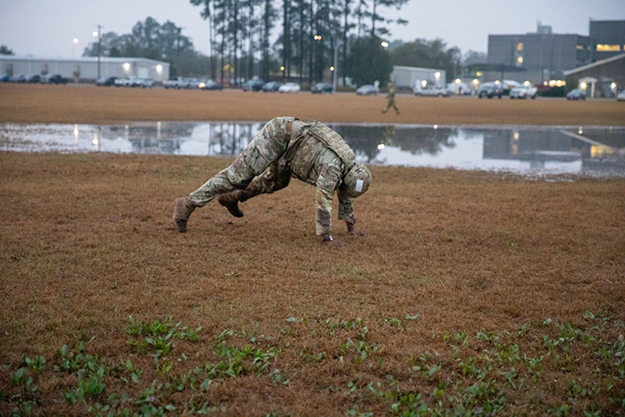JOINT BASE LANGLEY-EUSTIS, Va. - The Army's Expert Infantryman, Field Medical and Soldier badges will now share a common fitness assessment, while still maintaining the integrity and history of each badge.
The Expert Physical Fitness Assessment is a continuation of making it easier for units conducting three separate events throughout the year, much like the creation of the E3B. The EPFA considers how the Army now tests soldier fitness with the Army Combat Fitness Test, which replaced the Army Physical Fitness Test.
Previously, the badges used the legacy APFT or a modified version of new ACFT for the physical assessment. The implementation of the new EPFA allows units to reduce resources and personnel and provides a validated common standard for all soldiers striving to attain their respective expert badge. The EPFA is a combat-focused physical assessment and is conducted in the Army Combat Uniform, boots, "slick" body armor with plates and helmet.
Participants will start with a one-mile run, then complete dead-stop push-ups (a modified version of the hand-release push up), a 100-meter sprint, lift 16 sandbags onto a 66" tall platform, 50-meter farmers carry with two 40-pound water cans, a 25-meter-high crawl, a 25 meter three-five second rush, and another one-mile run. The seven events that make up the EPFA must be completed within 27:30 minutes for EIB or 30:00 minutes for ESB and EFMB.
"These are the movements you do as a soldier: high crawl, getting yourself off the ground, carrying things over distance, lifting things onto a platform," Sgt. Maj. Of the Army Michael Grinston said. "Having a single fitness assessment for the three badges will help flatten the requirements and provide more training and testing opportunities for all soldiers."
EPFA testing, piloting and validation began in Fall 2022. E3B candidates, male and female, conducted the EPFA at various installations across the Army. The data from those tests were analyzed by the Maneuver Command Center of Excellence (lead for EIB), Medical Center of Excellence (lead for EFMB) and Center for Initial Military Training (lead for ESB), which informed the adjustments made to the test.
The EPFA is the final part of aligning the badges. The E3B concept reduces the logistical burden on units and allows soldiers more opportunities to show their understanding and expertise of their craft. In addition to the EPFA, under the E3B concept the proponents for each badge have also aligned regulations, administrative requirements, land navigation, uniform, and road march.
"The E3B concept is designed to keep the integrity and history of the respective badges, while giving units more time and resources to prepare and execute the expert badge lanes," Command Sgt. Major Daniel Hendrex, U.S. Army Training and Doctrine Command said.
The EIB was created in 1944, the EFMB followed in 1965 and the ESB was first awarded in 2019.





Read Comments